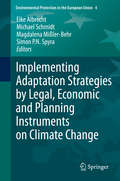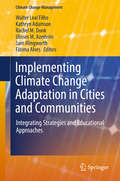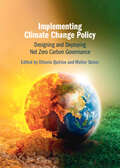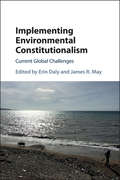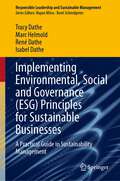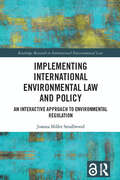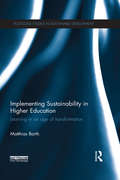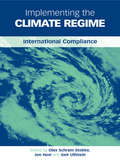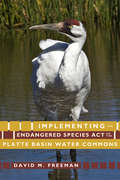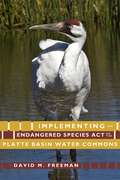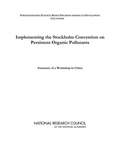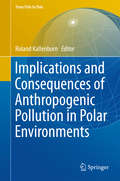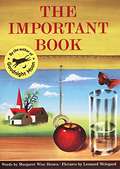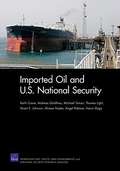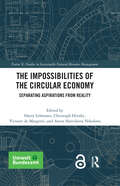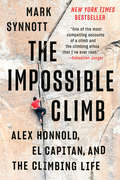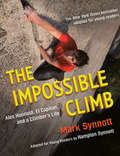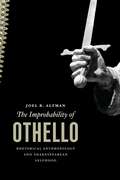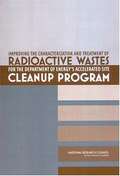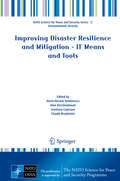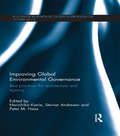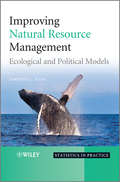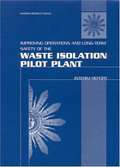- Table View
- List View
Implementing Adaptation Strategies by Legal, Economic and Planning Instruments on Climate Change
by Eike Albrecht Michael Schmidt Magdalena Mißler-Behr Simon P. N. SpyraThe causes and effects of climate change are just as varied as the proposed solutions and approaches for dealing with the problem. Given the global character of climate change, comprehensive global cooperation is called for that leads to effective and appropriate international action in accordance with the respective responsibilities. These will inevitably differ depending on the capabilities and the social and economic situations of the respective actors. The contributions in this book present a variety of ideas, approaches and tools regarding the adaptation to climate change in specific countries and regions. In addition to examining (existing) legal instruments, they also focus on the implementation of economic instruments and planning tools, as well as their (further) development. Rather than simply discussing strategies to counteract climate change by reducing emissions, the authors also search for ways of actively adapting to climate change.
Implementing Climate Change Adaptation in Cities and Communities
by Walter Leal Filho Kathryn Adamson Rachel M. Dunk Ulisses M. Azeiteiro Sam Illingworth Fátima AlvesThis book analyzes how climate change adaptation can be implemented at the community, regional and national level. Featuring a variety of case studies, it illustrates strategies, initiatives and projects currently being implemented across the world. In addition to the challenges faced by communities, cities and regions seeking to cope with climate change phenomena like floods, droughts and other extreme events, the respective chapters cover topics such as the adaptive capacities of water management organizations, biodiversity conservation, and indigenous and climate change adaptation strategies. The book will appeal to a broad readership, from scholars to policymakers, interested in developing strategies for effectively addressing the impacts of climate change.
Implementing Climate Change Policy: Designing and Deploying Net Zero Carbon Governance
by Ottavio Quirico Walter BaberThe chapters in this volume provide an interdisciplinary and comparative analysis of the implementation of climate change policies worldwide to assess whether they are meeting the aims set out in the 'Paris Agreement'. The first part compares climate policies employed by the EU, the US, Latin America, Russia, China, the Middle East, and Africa. The second explores ways of improving key regulatory mechanisms to increase the effectiveness of greenhouse gas mitigation and adaptation measures. This book argues that the international community should improve the effectiveness of enforcement mechanisms from the standpoint of secondary norms through an integrated approach. It is an indispensable resource for undergraduate and graduate students of environmental policy and governance, public policy, law and political science, as well as policy makers. This title is part of the Flip it Open Programme and may also be available as Open Access. Check our website - Cambridge Core - for details. (150, 992)
Implementing Environmental Constitutionalism: Current Global Challenges
by Erin Daly James R. MayConstitutions can play a central role in responding to environmental challenges, such as pollution, biodiversity loss, lack of drinking water, and climate change. The vast majority of people on earth live under constitutional systems that protect the environment or recognize environmental rights. Such environmental constitutionalism, however, falls short without effective implementation by policymakers, advocates and jurists. Implementing Environmental Constitutionalism: Current Global Challenges explains and explores this 'implementation gap'. This collection is both broad and deep. While some of the essays analyze crosscutting themes, such as climate change and the need for rule of law that affect the implementation of environmental constitutionalism throughout the world, others delve deeply into geographically contextual experiences for lessons about how constitutional environmental law might be more effectively implemented. This volume informs global conversations about whether and how environmental constitutionalism can be made more effective to protect the natural environment.
Implementing Environmental, Social and Governance: A Practical Guide in Sustainability Management (Responsible Leadership and Sustainable Management)
by Tracy Dathe Marc Helmold René Dathe Isabel DatheThe concept of environmental, social and governance (ESG) is rapidly emerging as the new global industry standard and an important benchmarking tool for socially responsible investments. Major corporations seek the expertise of specialized consultants to develop and implement tailored ESG framework for their businesses. This book offers a guide to ESG and its practical applications. Beyond introducing the structured procedures of the most common ESG approaches, it delves into the comprehensive impact on the value chain, providing practical insights. The text explores the latest trends in various business sectors, offering insights into their ESG practices. Closing with a forward-looking perspective, the book anticipates future developments such as climate change management and ESG certifications, while also addressing potential pitfalls encapsulated by the term “greenwashing”.Written by authors with a solid background in teaching and research, the book establishes a robust theoretical foundation. The inclusion of numerous practical examples and country-specific recommendations enhances this book’s applicability and makes it an invaluable resource to those navigating the complexities of ESG.
Implementing International Environmental Law and Policy: An Interactive Approach to Environmental Regulation (Routledge Research in International Environmental Law)
by Joanna Miller SmallwoodThis book introduces a novel discourse, based on socio-legal theory of compliance with international environmental law, which addresses the overarching question: When can international environmental law and policy achieve implementation, compliance, and be effective?Offering an important contribution to academic and practical understandings of implementation and compliance with international environmental obligations, the book firstly critiques existing multidisciplinary theories of law and then brings together international and domestic legal theories to highlight their symbiotic relationship. It also stresses the importance of interactions between domestic and international legal and policy processes. This pioneering discourse is argued to be transformative to international environmental regimes and offers a way for them to be truly normative and to achieve compliance.The book will be of interest to students and scholars in the field of socio-legal studies and international environmental law and policy.The Open Access version of this book, available at http://www.taylorfrancis.com, has been made available under a Creative Commons Attribution-Non Commercial-No Derivatives (CC-BY-NC-ND) 4.0 license.
Implementing Sustainability in Higher Education: Learning in an age of transformation (Routledge Studies in Sustainable Development)
by Matthias BarthIn a time of unprecedented transformation as society seeks to build a more sustainable future, education plays an increasingly central role in training key agents of change. This book asks how we can equip students and scholars with the capabilities to promote sustainability and how the higher education curriculum can be changed to facilitate the paradigm shift needed. Across the globe, a rising number of higher education institutions and academics are responding to these questions by transforming their own teaching and learning and their institutions’ curricula. This book contributes to that development by examining in-depth case studies of innovative approaches and curriculum changes at multiple levels of the education sector. Elaborating key principles of higher education for sustainable development and identifying drivers and barriers to implementing sustainability in the curriculum, the book provides a comprehensive overview of what makes higher education for sustainable development a unique field of research and practice, as well as offering a coherent narrative of how change can be effected in it. This much-needed book is a valuable resource to inform, guide and inspire students, academics, administrators and community partners, whether experienced or new to the field, whether already committed or not to higher education for sustainable development in an age of transformation.
Implementing the Climate Regime: International Compliance
by Olav Schram StokkeGlobal warming is the most severe environmental challenge faced by humanity today and the costs of responding effectively will be high. While Russia's ratification of the Kyoto Protocol ensures the treaty's entry into force, lack of capacity, or incentives to renege on their commitments, will impede mitigation efforts in many countries. An important prerequisite for the proper functioning of the Protocol is that its compliance system - which is spelled out by the Marrakesh Accords - proves effective. Implementing the Climate Regime describes and analyses Kyoto's compliance system. Organized into four parts, Part I describes the emergence and design of the compliance system, while Part II analyses various challenges to its effective operation - such as the development of norms, verification and the danger that the use of punitive 'consequences' may also hurt compliant countries. Part III discusses the potential role of external enforcement, with particular emphasis on trade sanctions. Part IV addresses the relationship between Kyoto compliance on one hand, and international governance, oil companies and green NGOs on the other.
Implementing the Endangered Species Act on the Platte Basin Water Commons (G - Reference, Information And Interdisciplinary Subjects Ser.)
by David M. FreemanWater users of the Platte River Basin have long struggled to share this scarce commodity in the arid high plains, ultimately organizing collectively owned and managed water systems, allocating water along extensive stream systems, and integrating newer groundwater with existing surface-water uses. In 1973, the Endangered Species Act brought a new challenge: incorporating the habitat needs of four species-the whooping crane, piping plover, least tern, and pallid sturgeon-into its water-management agenda. Implementing the Endangered Species Act on the Platte Basin Water Commons tells of the negotiations among the U.S. Department of the Interior, the environmental community, and the states of Wyoming, Colorado, and Nebraska that took place from the mid-1970s to 2006. Ambitious talks among rival water users, environmentalists, state authorities, and the Department of the Interior finally resulted in the Platte River Habitat Recovery Program. Documenting how organizational interests found remedies within the conditions set by the Endangered Species Act, describing how these interests addressed habitat restoration, and advancing sociological propositions under which water providers transcended self-interest and produced an agreement benefiting the environment, this book details the messy process that took place over more than thirty years. Presenting important implications for the future of water management in arid and semi-arid environments, this book will be of interest to anyone involved in water management, as well as academics interested in the social organization of common property.
Implementing the Endangered Species Act on the Platte Basin Water Commons
by David M. FreemanWater users of the Platte River Basin have long struggled to share this scarce commodity in the arid high plains, ultimately organizing collectively owned and managed water systems, allocating water along extensive stream systems, and integrating newer groundwater with existing surface-water uses. In 1973, the Endangered Species Act brought a new challenge: incorporating the habitat needs of four species-the whooping crane, piping plover, least tern, and pallid sturgeon-into its water-management agenda. Implementing the Endangered Species Act on the Platte Basin Water Commons tells of the negotiations among the U.S. Department of the Interior, the environmental community, and the states of Wyoming, Colorado, and Nebraska that took place from the mid-1970s to 2006. Ambitious talks among rival water users, environmentalists, state authorities, and the Department of the Interior finally resulted in the Platte River Habitat Recovery Program. Documenting how organizational interests found remedies within the conditions set by the Endangered Species Act, describing how these interests addressed habitat restoration, and advancing sociological propositions under which water providers transcended self-interest and produced an agreement benefiting the environment, this book details the messy process that took place over more than thirty years. Presenting important implications for the future of water management in arid and semi-arid environments, this book will be of interest to anyone involved in water management, as well as academics interested in the social organization of common property.
Implementing the Stockholm Convention on Persistent Organic Pollutants: Summary of a Workshop in China
by National Research Council of the National AcademiesThis report summarizes a workshop --- Strengthening Science-Based Decision-Making: Implementing the Stockholm Convention on Persistent Organic Pollutants held June 7-10, 2004, in Beijing, China. The presentations and discussions summarized here describe the types of scientific information necessary to make informed decisions to eliminate the production and use of Persistent Organic Pollutants (POPs) banned under the Stockholm Convention, sources of information; scientifically informed strategies for eliminating POPs, elements of good scientific advice, such as transparency, peer review, and disclosure of conflicts of interest; and information dealing with POPs that decision makers need from the scientific community, including next steps to make such science available and ensure its use on a continuing basis.
Implications and Consequences of Anthropogenic Pollution in Polar Environments
by Roland KallenbornThe first evidence on the adverse effects of organic pollutants on Arctic ecosystems was provided by international research initiatives more than 30 years ago. Today, the indigenous people of the North are considered to be affected by exposure to persistent organic pollutants (POPs) and metals through their traditional marine food sources. The occurrence of pollutants of emerging concern in remote Polar environments is considered an essential criterion for prioritising this (largely neglected) type of contamination in national, international and global regulation schemes. Initiated during the first international Polar Years (IPY 2007-2009) and continued afterwards, 11 representative initiatives and projects are summarised as chapters in this book, which highlights today's interdisciplinary research on POPs in the Polar environment. The individual chapters describe in detail the consequences, priorities and perspectives of international research on POPs (legacy and emerging xenobiotics), its implications for regulations and scientific priorities including societal and cultural developments in the Arctic, as well as conservation priorities in Antarctica. This book is intended for all readers interested in learning more about modern research on environmental pollutants in the Polar environments (with a strong focus on Arctic environments). The impacts of pollution and climate change on Polar regions and the world as a whole will continue to be felt for many years to come. Sound science is, thus, vital in order to underpin actions that need to be taken at the global, regional and local levels. This book contributes to this highly relevant, interdisciplinary environmental scientific endeavour.
The Important Book (Into Reading, Read Aloud Module 2 #1)
by Leonard Weisgard Margaret BrownNIMAC-sourced textbook <p><p> Margaret Wise Brown, the New York Times bestselling author of the perennial classics Goodnight Moon and Runaway Bunny, asks children to think deeply about the importance of everyday objects, from apples to spoons. With lyrical words and vivid illustrations by Caldecott winner Leonard Weisgard, The Important Book shows children just how important everyday objects can be. <p> What is the most important thing about a spoon? The fact that you can eat with it? What about an apple? Or a shoe? This book helps curious preschoolers notice important details about their everyday surroundings, like daisies are white, rain is wet, and a spoon is used for eating.
Imported Oil and U.S. National Security
by Keith Crane Stuart E. Johnson Michael Toman Andreas Goldthau Thomas LightIn 2007, the United States imported 58 percent of the oil it consumed. This book critically evaluates commonly suggested links between these imports and U.S. national security and assesses the economic, political, and military costs and benefits of potential policies to alleviate imported oil?related challenges to U.S. national security.
The Impossibilities of the Circular Economy: Separating Aspirations from Reality (Factor X: Studies in Sustainable Natural Resource Management)
by Harry Lehmann Christoph Hinske Victoire De Margerie Aneta Slaveikova NikolovaThe fifth Factor X publication from the Federal Environment Agency (Umweltbundesamt, UBA), The Impossibilities of the Circular Economy provides an overview of the limits to the circular economy, emphasising the relationship between integrated resource use and more systemic leadership-management approaches. On a European level, the book ties into the recent European Green Deal and aims to empower actors across sectors and EU member countries to transition from existing linear models of value capture and expression to more systemic-circular solutions of value capture and expression. The volume provides a hands-on contribution towards building the knowledge and skill sets of current and future decision-makers who face these complex-systemic crises in their day-to-day business. The book further provides access to best practices from cutting-edge research and development findings, which will empower decision-makers to develop a more sustainable and equitable economy. Providing solutions for a more sustainable economy, this book is essential reading for scholars and students of natural resource use, sustainable business, environmental economics and sustainable development, as well as decision-makers and experts from the fields of policy development, industry and civil society. The Open Access version of this book, available at www.taylorfrancis.com, has been made available under a Creative Commons Attribution- Non Commercial- No Derivatives 4.0 license.
The Impossible Climb: Alex Honnold, El Capitan, and the Climbing Life
by Mark SynnottIf you loved watching Free Solo, you’ll be enthralled by Mark Synnott’s deeply reported, insider perspective."One of the most compelling accounts of a climb and the climbing ethos that I've ever read."--Sebastian JungerIn Mark Synnott’s unique window on the ethos of climbing, his friend Alex Honnold’s astonishing “free solo” ascent of El Capitan’s 3,000 feet of sheer granite, is the central act. When Honnold topped out at 9:28 A.M. on June 3, 2017, having spent fewer than four hours on his historic ascent, the world gave a collective gasp. The New York Times described it as “one of the great athletic feats of any kind, ever.” Synnott’s personal history of his own obsession with climbing since he was a teenager—through professional climbing triumphs and defeats, and the dilemmas they render—makes this a deeply reported, enchanting revelation about living life to the fullest. What are we doing if not an impossible climb?Synnott delves into a raggedy culture that emerged decades earlier during Yosemite’s Golden Age, when pioneering climbers like Royal Robbins and Warren Harding invented the sport that Honnold would turn on its ear. Painting an authentic, wry portrait of climbing history and profiling Yosemite heroes and the harlequin tribes of climbers known as the Stonemasters and the Stone Monkeys, Synnott weaves in his own experiences with poignant insight and wit: tensions burst on the mile-high northwest face of Pakistan’s Great Trango Tower; fellow climber Jimmy Chin miraculously persuades an official in the Borneo jungle to allow Honnold’s first foreign expedition, led by Synnott, to continue; armed bandits accost the same trio at the foot of a tower in the Chad desert . . .The Impossible Climb is an emotional drama driven by people exploring the limits of human potential and seeking a perfect, choreographed dance with nature. Honnold dared far beyond the ordinary, beyond any climber in history. But this story of sublime heights is really about all of us. Who doesn’t need to face fear down fear and make the most of the time we have?
The Impossible Climb (Young Readers Adaptation): Alex Honnold, El Capitan, and a Climber's Life
by Mark Synnott Hampton SynnottA middle grade adaptation of the adult bestseller that chronicles what The New York Times deemed "one of the great athletic feats of any kind, ever": Alex Honnold's free-solo ascent of El Capitan in Yosemite National Park.On June 3, 2017, as seen in the Oscar-winning documentary Free Solo, Alex Honnold achieved what most had written off as unattainable: a 3,000-foot vertical climb of El Capitan in Yosemite National Park, without a rope or harness. At the time, only a few knew what he was attempting to do, but after topping out at 9:28 am, having spent just under four hours on this historic feat, author Mark Synnott broke the story for National Geographic and the world watched in awe.Now adapted for a younger audience, The Impossible Climb tells the gripping story of how a quiet kid from Sacramento, California, grew up to capture the attention of the entire globe by redefining the limits of human potential through hard work, discipline, and a deep respect for the natural world.
The Improbability of Othello: Rhetorical Anthropology and Shakespearean Selfhood
by Joel B. AltmanShakespeare’s dramatis personae exist in a world of supposition, struggling to connect knowledge that cannot be had, judgments that must be made, and actions that need to be taken. For them, probability—what they and others might be persuaded to believe—governs human affairs, not certainty. Yet negotiating the space of probability is fraught with difficulty. Here, Joel B. Altman explores the problematics of probability and the psychology of persuasion in Renaissance rhetoric and Shakespeare’s theater.Focusing on the Tragedy of Othello, Altman investigates Shakespeare’s representation of the self as a specific realization of tensions pervading the rhetorical culture in which he was educated and practiced his craft. In Altman’s account, Shakespeare also restrains and energizes his audiences’ probabilizing capacities, alternately playing the skeptical critic and dramaturgic trickster. A monumental work of scholarship by one of America’s most respected scholars of Renaissance literature, The Improbability of Othello contributes fresh ideas to our understanding of Shakespeare’s conception of the self, his shaping of audience response, and the relationship of actors to his texts.
The Improbable Shepherd
by Sylvia Jorrin Joshua Kilmer-Purcell"The lessons of Sylvia's farm are not just applicable for those who dream of living the rural life. They're universally instructive, and joyfully addictive." --Joshua Kilmer-Purcell, The Fabulous Beekman BoysIn this sequel to her popular first collection, Sylvia Jorrín returns with more vignettes -- along with personal photos, artwork, and recipes--from her life on thefarm to again inspire readers old and new. The Improbable Shepherd is a continuation of Sylvia's Farm, covering the past five years of her experiences on a rural sheep farm. This book brings readers closer to the world around them, and to recognize the simple, often hidden beauties it holds. Told in short vignettes and anecdotes, it is a journal of the continuing growth, persistence, and hope that each new day can bring.Nearly a decade after the publication of her first book, life on Sylvia Jorrin's farm continues to present our improbable shepherdess with new opportunities to appreciate the peace and unexpected joys that farm life brings despite too many tasks and too little time.The Improbable Shepherd immerses the reader fully in Sylvia's farm, echoing her own experiences living with the land and includes photos, and illustrations and Sylvia's personal recipes. Appealing to those who loved Sylvia's first book and want to return, as well as for all the newcomers who have yet to discover Sylvia's powerful prose and earnest message, The Improbable Shepherd will inspire you to follow your dreams, whatever they may be.
An Improper Proposal
by Patricia Cabot Meg CabotA fearless young woman scandalously pursues the captain of her heart in this adventuresome Victorian romance.England, 1830. Swashbuckling beauty Payton Dixon has two passionate dreams—to sail the open sea on her own clipper ship, and to capture the love of Captain Connor Drake. But both seem impossibly out of reach, since her beloved captain is about to marry another, and worse, he’s been given her ship as a wedding present from her traitorous father.Out to prove she has right on her side, Payton manages to unleash a scandal and ignite all sorts of trouble. As for Drake, he’s surprised to discover that the girl he’s grown up with has transformed into the most alluring woman he’s ever encountered.
Improving The Characterization And Treatment Of Radioactive Wastes For The Department Of Energy's Accelerated Site Cleanup Program
by National Research Council of the National AcademiesThe Department of Energy’s Office of Environmental Management (EM) directs the massive cleanup of more than 100 sites that were involved in the production of nuclear weapons materials during the Manhattan Project and the Cold War. This report offers suggestions for more effectively characterizing and treating the orphan and special-case wastes that are part of EM’s accelerated cleanup program. It identifies technical opportunities for EM to improve the program that will save time and money without compromising health and safety. The opportunities identified include: making more effective use of existing facilities and capabilities for waste characterization, treatment, or disposal; eliminating self-imposed requirements that have no clear technical or safety basis; and investing in new technologies to improve existing treatment and characterization capabilities. For example, the report suggests that EM work with DOE classification officers to declassify, to the extent possible, classified materials declared as wastes. The report also suggests a new approach for treating the wastes that EM will leave in place after cleanup.
Improving Disaster Resilience and Mitigation - IT Means and Tools
by Horia-Nicolai Teodorescu Alan Kirschenbaum Svetlana Cojocaru Claude BruderleinThe focus of this volume is comprised of the fundamentals, models, and information technologies (IT) methods and tools for disaster prediction and mitigation. A more detailed list of topics includes mathematical and computational modeling of processes leading to or producing disasters, modeling of disaster effects, IT means for disaster mitigation, including data mining tools, knowledge-based and expert systems for use in disaster circumstances, GIS-based systems for disaster prevention and mitigation and equipment for disaster-prone areas. A specific type or class of disasters (natural or human-made), however will not be part of the main focus of this work. Instead, this book was conceived to offer a comprehensive, integrative view on disasters, seeking to determine what various disasters have in common. Because disaster resilience and mitigation involve humans, societies and cultures, not only technologies and economic models, special attention was paid in this volume to gain a comprehensive view on these issues, as a foundation of the IT tool design.
Improving Global Environmental Governance: Best Practices for Architecture and Agency (Routledge Research in Global Environmental Governance)
by Norichika Kanie Steinar Andresen Peter M. HaasThe experience of environmental governance is approached in Improving Global Environmental Governance from the unique perspective of actor configuration and embedded networks of actors, which are areas of emerging importance. The chapters look at existing Multilateral Environmental Agreements (MEAs) and the broader constellation of partially networked institutions to better understand the involvement of individual actors and how to deepen the networks that include them to generate more effective governance. The book covers a wide range of issued pertaining to environmental governance including trans-boundary air pollution, marine pollution, biodiversity and ozone depletion. It also examines partnerships as a hybrid case of emerging modes of environmental governance. These partnerships are a recent form of actor configuration that warrant attention for dealing with global environmental threats in order to better understand the full potential of actor configurations in the absence of state involvement. In order to test applicability to on-going but stalled processes, the book applies the approach to one of the most difficult issues we face: climate change. By addressing key questions in this important area, the book provides new perspectives in the nexus between agency and architecture in environmental governance in the twenty-first century.
Improving Natural Resource Management
by Timothy C. HaasThe decision to implement environmental protection options is a political one. These, and other political and social decisions affect the balance of the ecosystem and how the point of equilibrium desired is to be reached. This book develops a stochastic, temporal model of how political processes influence and are influenced by ecosystem processes and looks at how to find the most politically feasible plan for managing an at-risk ecosystem. Finding such a plan is accomplished by first fitting a mechanistic political and ecological model to a data set composed of observations on both political actions that impact an ecosystem and variables that describe the ecosystem. The parameters of this fitted model are perturbed just enough to cause human behaviour to change so that desired ecosystem states occur. This perturbed model gives the ecosystem management plan needed to reach desired ecosystem states. To construct such a set of interacting models, topics from political science, ecology, probability, and statistics are developed and explored.Key features:Explores politically feasible ways to manage at-risk ecosystems.Gives agent-based models of how social groups affect ecosystems through time.Demonstrates how to fit models of population dynamics to mixtures of wildlife data.Presents statistical methods for fitting models of group behaviour to political action data.Supported by an accompanying website featuring datasets and JAVA code.This book will be useful to managers and analysts working in organizations charged with finding practical ways to sustain biodiversity or the physical environment. Furthermore this book also provides a political roadmap to help lawmakers and administrators improve institutional environmental management decision making.
Improving Operations And Long-term Safety Of The: Interim Report
by Committee on the Waste Isolation Pilot PlantThe National Academies Press (NAP)--publisher for the National Academies--publishes more than 200 books a year offering the most authoritative views, definitive information, and groundbreaking recommendations on a wide range of topics in science, engineering, and health. Our books are unique in that they are authored by the nation's leading experts in every scientific field.
